*Author: Chris Zheng
On September 22, 2020, Tesla CEO Elon Musk announced to the world the new generation of Tesla batteries: the 4680 cylindrical battery.
The new battery has a diameter of 46 mm and a height of 80 mm. Compared to the widely produced 2170 battery, the 4680 has improved in multiple dimensions, such as energy density, fast charging/discharging performance, cost, and safety. It will be the main battery for Tesla’s future product line.
It is a weapon for the Tesla Model 3 & Y to break through the 100 kWh battery capacity.
Not just a battery
What makes the 4680 cylindrical battery so good?
Tesla co-founder JB Straubel said that there are certain indicators that cannot be compromised when it comes to electric vehicle power batteries, such as safety, performance, and, most importantly, cost. Safety, performance, and cost are the three dimensions that Tesla improved on when enhancing its battery.
Let’s go back to the Tesla battery day two months ago and take a look at this PPT.
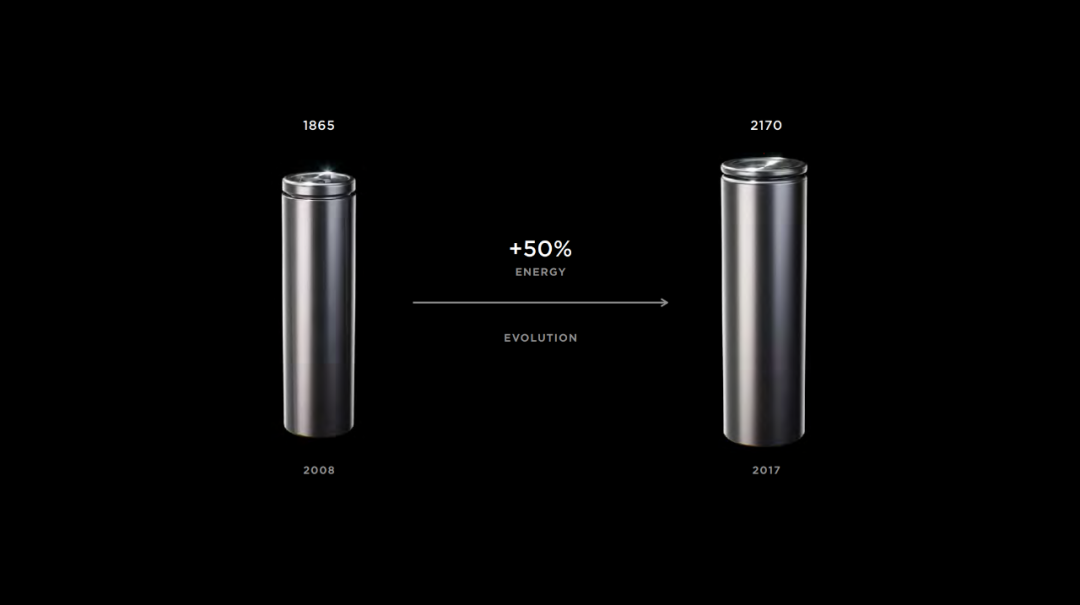
The rated capacity of the Tesla battery cell has doubled from 1865 in 2008 to 2170 in 2017, and the rated capacity of the 4680 is five times that of the 2170 and ten times that of the 1865.
What are the benefits of moving from “small cylindrical cells” to “large cylindrical cells”?
The Model S P85 battery pack has a capacity of 85 kWh, and Tesla needs to manage 7104 1865 cells. The Model 3 (long range) battery pack also has a capacity of 80.5 kWh, but it only needs to manage 4416 2170 cells.
With nearly half the number of cells, the difficulty of battery thermal management is greatly reduced, and the complexity of the entire thermal management system is reduced, which in turn leads to cost reduction.
Wait, why 4680 instead of 5680 or 6680?
Let’s take a look at this PPT.
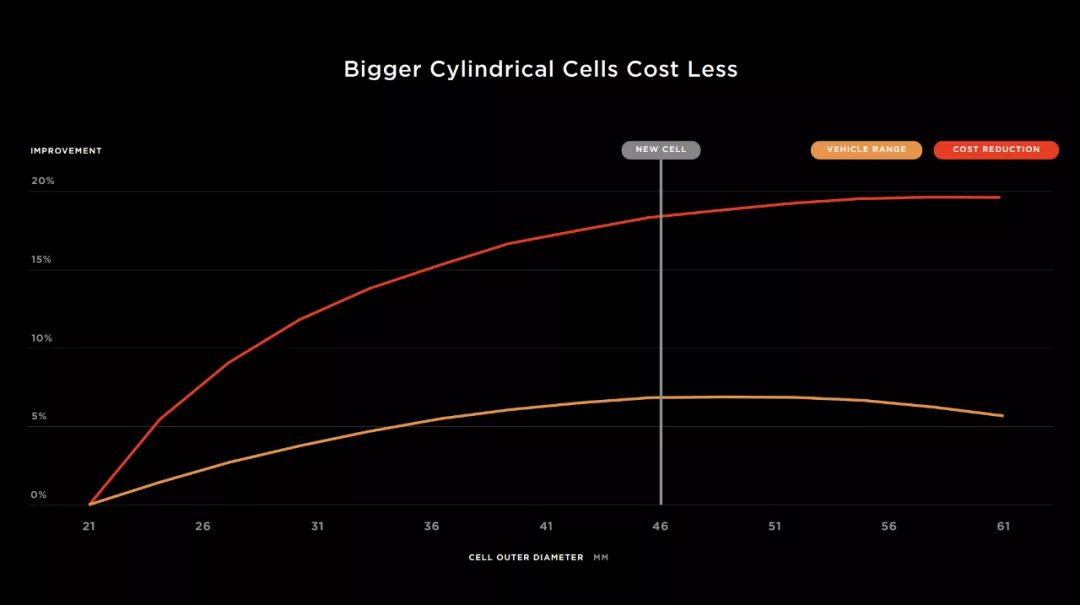
As the diameter of the small cylindrical cell gradually increases, the cost reduction curve gradually flattens out, while the performance (in this case, range) improvement curve decreases.
The highest critical point of these two curves, which is the best balance point between performance and cost, is when the diameter equals 46 mm. This is the reason for the new battery’s diameter of 46 mm per cell.Why is the height 80 mm? Why not 4690 or 46100?
Take a look at this PPT.
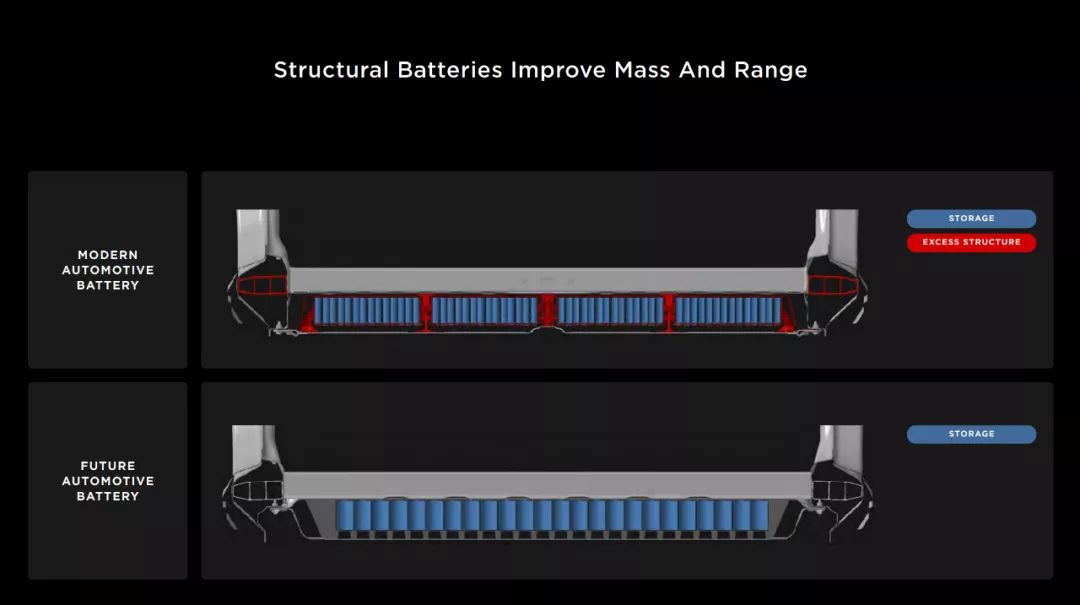
In the upper part of the picture, “Current Car Battery” as shown in the figure, there are two red horizontal energy-absorbing cavities on the left and right sides respectively, and the battery pack is divided into four parallel long strip module by the three red supports in the middle, which are filled with blue 2170 individual “small cylinders” in the center.
Take a look at the lower part of the picture, “Future Car Battery”. Tesla has removed the solid module and battery pack, and directly integrated the 4680 “big cylinder” battery cells into the vehicle chassis.
Let me give you some background: how many steps are required to install batteries into a car?
In Tesla’s previous process, three steps were required:
Assembling the battery cells into shoebox-sized modules.
Assembling the modules into battery packs.
Integrating the battery pack into the chassis.
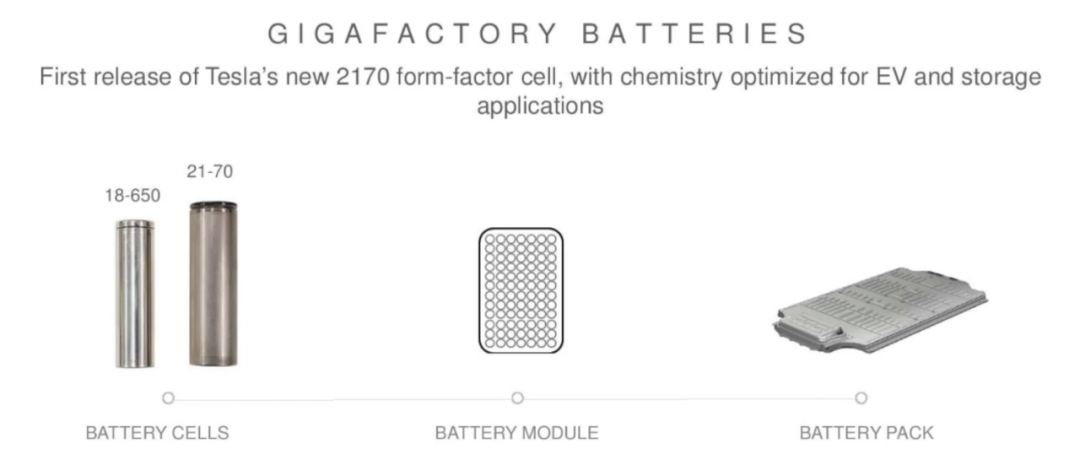
The “future car battery” demonstrated by Tesla has been simplified into one step:
Integrating battery cells into the chassis.
By completely removing the modules and battery packs, the battery cells become more compact, the number of battery components will decrease sharply, and the space utilization rate of the chassis will be greatly improved, which will lead to a decline in system costs.
According to Tesla’s data, replacing 2170 with 4680 cells and integrating them into the chassis will increase the vehicle’s range by 30% and decrease cost by 39%. The investment cost of unit battery production capacity will decrease by 49%.
Two American electrical and electromechanical engineers, George Bower and Keith Ritter, who have been following Tesla for a long time, have designed a 96S9P, a total of 76 kWh 4680 battery pack, which is superimposed on the Model 3 battery pack.
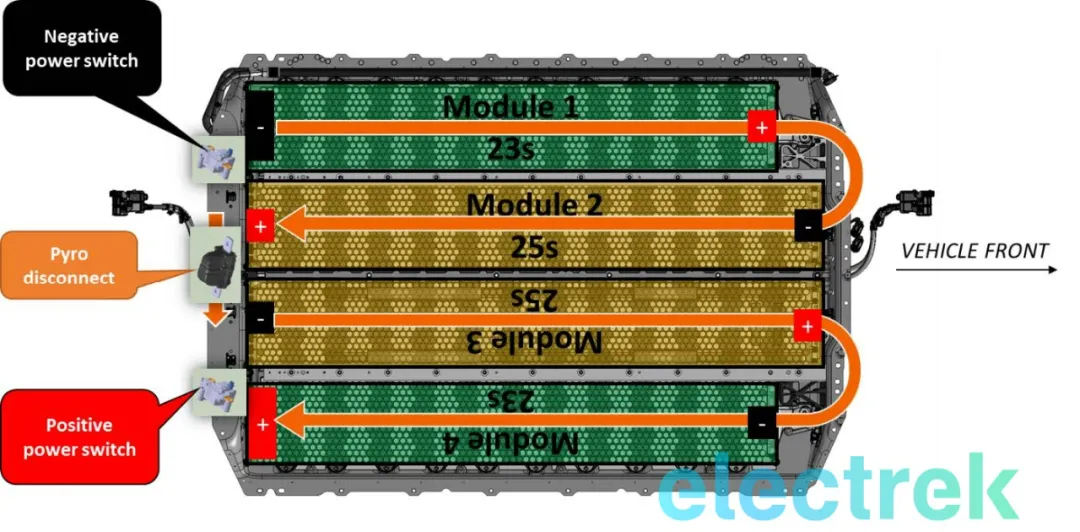
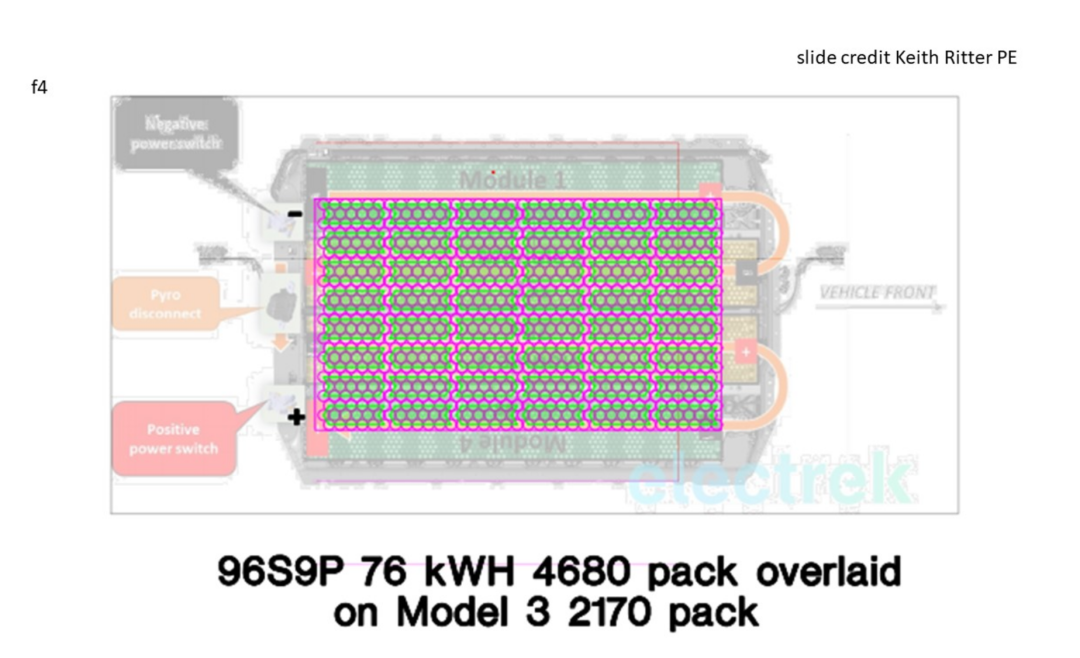
If this picture is not intuitive enough, then the following shows the effect of a 95 kWh 4680 battery pack. It can be seen that the utilization rate of the entire chassis is not very high, and it is not surprising for Tesla to achieve over 100 kWh by switching from 2170 to 4680 as the usual style.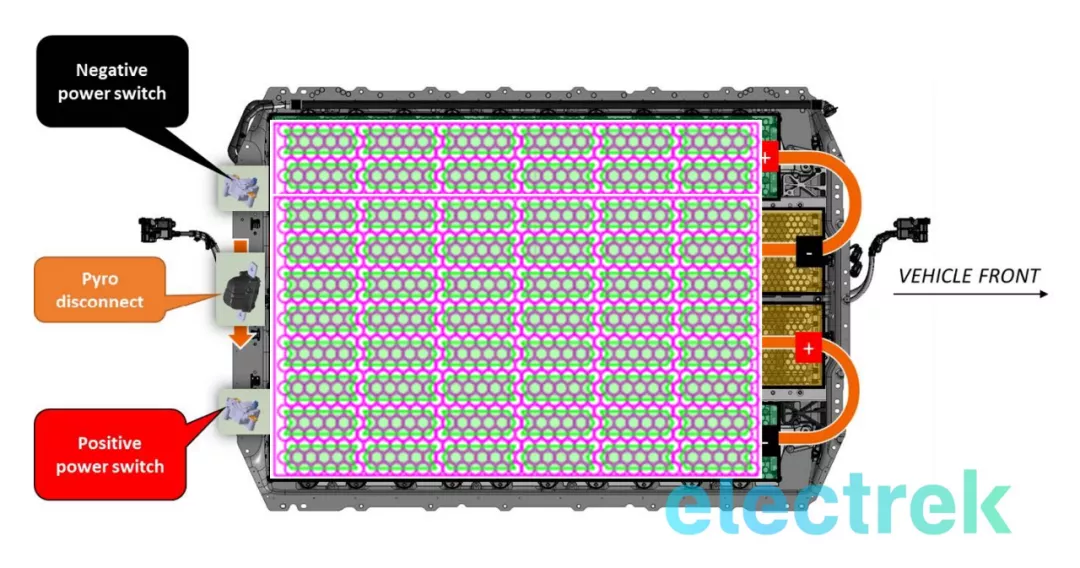
Let’s talk about safety issues now.
In junior high school physics class, we learned about the charging and discharging process of batteries:
During the charging phase, electrons on the positive electrode will run to the negative electrode through the external circuit, and positive lithium ions Li+ will pass through the electrolyte from the positive electrode to finally reach the negative electrode.
During the discharging phase, electrons on the negative electrode move to the positive electrode through the external circuit, and positive lithium ions Li+ cross the electrolyte from the negative electrode to finally reach the positive electrode, combining with electrons.
We all understand this principle, but the problem lies in the fact that the charging and discharging process of batteries in actual scenarios will severely test a small and thin slice: the tab.
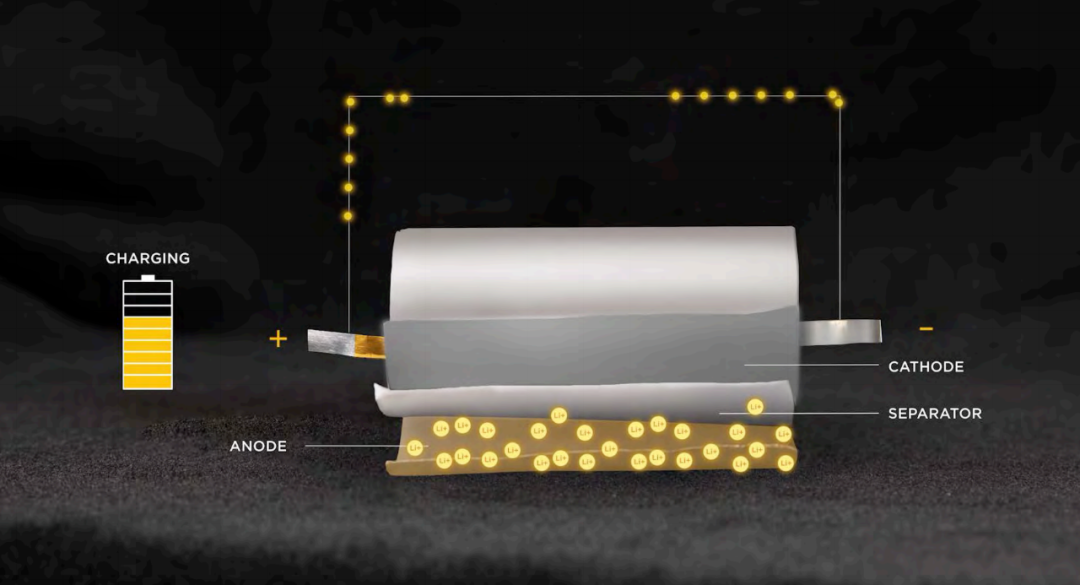
As mentioned earlier, during the transition from 1865 “small cylinder” to 4680 “large cylinder”, the rated capacity of the battery has increased tenfold. With the tabs unchanged, the channels for electron movement during the charging and discharging process have become infinitely “crowded”.
At the same time, as the diameter of the individual cells has also doubled, the lateral heat dissipation capability of the battery starts to decrease. This has led to the fact that the side-inserted liquid-cooled serpentine pipe thermal management scheme used from Roadster to Model S and then to Model 3 is no longer applicable.
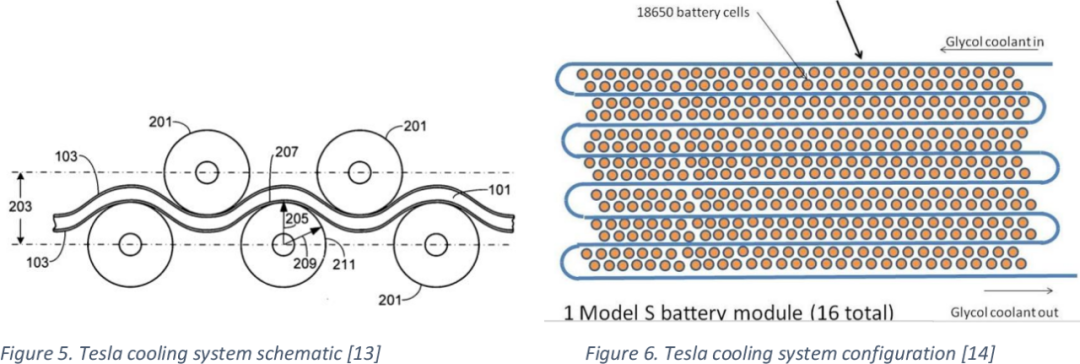
During fast charging and discharging, if there is no efficient heat dissipation design, a large amount of heat will quickly accumulate inside the battery. This is why Tesla said on Battery Day that the biggest challenge of the large cylinder is cooling.
To solve this problem, Tesla has introduced tabless design + bottom liquid cooling for the 4680 battery.
The tabless design, also known as the full tab design, according to Ravi Kempaiah, a storage material scientist at the University of Illinois Chicago, estimates that the 4680 tabless design reduces the internal resistance of the battery to only 2-3 milliohms, compared to the 20-23 milliohms for the 2170 battery.
The former is one-tenth of the latter, which is consistent with Tesla’s tabless patent, which states that “the internal resistance of the battery will drop to 5%-20% of the traditional battery’s internal resistance”.
In addition, as mentioned earlier, when fast charging and discharging, a large amount of heat will spurt from the positive and negative electrodes. Tesla has replaced the side serpentine pipe cooling with the bottom liquid cooling scheme, which can take away heat more efficiently.
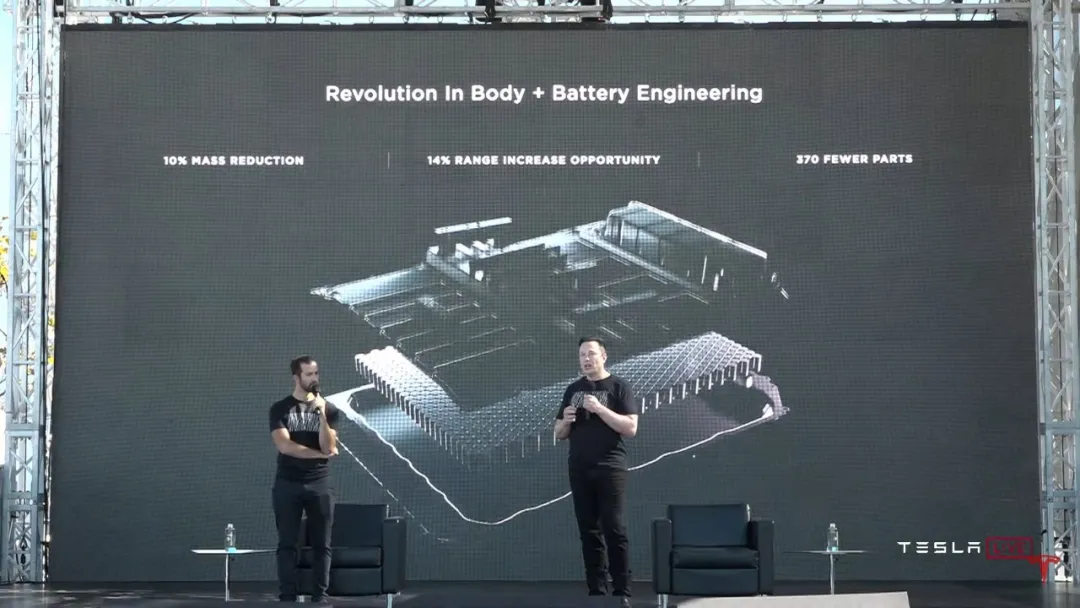 Using Supercharging as an example, if Tesla continues to use the single-pole ear design of 2170 battery cells, the charging time will be significantly extended due to ineffective heat dissipation (dashed lines), but if the design is changed to a pole-less ear design, the charging time of 4680 and 2170 cells with the same specifications will hardly change.
Using Supercharging as an example, if Tesla continues to use the single-pole ear design of 2170 battery cells, the charging time will be significantly extended due to ineffective heat dissipation (dashed lines), but if the design is changed to a pole-less ear design, the charging time of 4680 and 2170 cells with the same specifications will hardly change.
Therefore, the change from a “small cylinder” to a “large cylinder” in the form of single cells is not the only thing that 4680 represents. Behind it, there is Tesla’s new generation of thermal management design, cell and vehicle chassis integration design. In short, 4680 represents Tesla’s next-generation vehicle engineering technology.
So, when will the production be launched?
Domestic Model Y, domestic 4680
After the financial conference of Tesla, Panasonic, and LG Chem, we finally have the opportunity to sort out the global production capacity layout of Tesla’s 4680 battery cells.
On October 21st, Elon announced at the Tesla financial conference: We expect the Giga Berlin plant to establish Tesla’s first self-developed battery (i.e. 4680) production line.
Drew Baglino, Senior Vice President of Powertrain and Energy Engineering at Tesla: We will use the 4680 trial production line in Fremont, California to support the (battery) demand of the Berlin plant.
However, Elon also mentioned: We are delaying our self-developed batteries to 2021 to minimize risk and reduce our dependency on internal cell production. It’s very, very small.
What if Tesla’s self-developed battery “production hell” happens? Then it will be Panasonic’s turn.
On October 29th, Panasonic CFO Hirokazu Umeda stated at the financial conference: We started research and development immediately after the Tesla Battery Day and prepared to establish a (4680) prototype production line.
On November 18th, Panasonic signed a memorandum of understanding with energy company Equinor and industrial group Hydro to explore the establishment of a super battery factory in Norway.
The cooperation announcement did not show any information related to Tesla, but the senior executives responsible for signing the contract at Panasonic (left one) is Allan Swan, the president of Panasonic Energy North America.A factory in Europe was signed by a senior executive in charge of North American operations? Let me clarify the question: Allan Swan is permanently stationed at Tesla’s Gigafactory in Nevada, responsible for the production and delivery of Tesla batteries.
Panasonic’s spokesperson further clarified the purpose of the plant after its official announcement: the factory can provide cylindrical batteries for Tesla’s first car factory in Europe.
And what about China? For Tesla, battery supply in China depends on two companies: CATL and LG Chem.
Let’s talk about CATL first. Tesla did test and adapt to CATL’s NCM 811 battery early on, and it is expected that the domestic Tesla CATL ternary version will be launched in 2021.
However, compared with CATL’s production of the 4680 large cylindrical battery, it is not a challenge in the same dimension. From CATL’s history, the probability of developing and building 4680 large cylindrical battery production lines for Tesla is not high.
Next is LG Chem. On October 21, Lun Cha, head of LG Chem’s energy solutions strategy department, said LG Chem had developed new cylindrical products with rated capacity increased by five times and output power increased by six times – this is completely consistent with the parameters of Tesla’s 4680 battery.
However, Lun Cha also stated that LG Chem is considering building new factories in Europe and North America to increase capacity from 120 GWh/year to 260 GWh/year. Only China is absent.
What about China?
Well, as early as October 7, Elon announced not only 4680 batteries and battery pack integration into chassis technology, but also Tesla’s integrated casting technology and next-generation painting systems. This wave of new technology will be concentrated in the Berlin factory.
After the new technology is fully verified and the capacity is ramped up, the Shanghai and California factories will complete the iteration of the technology within the next two years.
Whether it is the Model 3 or Model Y, geek users in China have not been able to experience the cutting-edge technology that leads the industry in the first batch.
But then again, Tesla has always been radical in commercializing advanced technology. The first batch of Model 3 was tested by “guinea pigs” in North America, and the first batch of Model Y was tested by “guinea pigs” in Europe. Isn’t it a good thing?
This article is a translation by ChatGPT of a Chinese report from 42HOW. If you have any questions about it, please email bd@42how.com.
